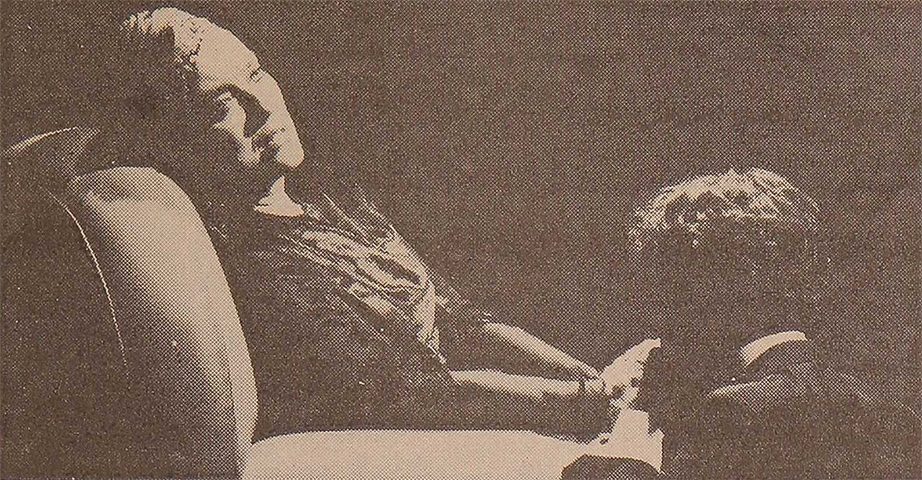Debutto: Torino, Teatro Carignano, 9 ottobre 1961 (filmato RaiTeche)
| Regia | Luigi Squarzina |
| Regista assistente | Paolo Giuranna |
| Scene e costumi | Pier Luigi Pizzi |
| Produzione | Teatro Stabile di Genova |
Personaggi e interpreti
Il dramma vero
| La Moreno, che tutti sanno chi è | Paola Mannoni |
| Il barone Nuti | Claudio Camaso |
La commedia sul palcoscenico
| Delia Morello | Lydia Alfonsi |
| Michele Rocca | Turi Ferro |
| La vecchia signora Donna Livia Palegari | Karola Zopegni |
| Primo vecchio amico / invitato | Nico Pepe |
| Secondo vecchio amico / invitato | Pier Paolo Porta |
| Il giovane sottile / invitato | Giorgio De Virgiliis |
| Primo giovane annoiato / invitato | Antonio Meschini |
| Secondo giovane annoiato / invitato | Emilio Cappuccio |
| Prima giovane signora / invitata | Carla Greco |
| Seconda giovane signora / invitata | Dina Braschi |
| Doro Palegari, figlio di Donna Livia Palegari / invitato | Mario Valdemarin |
| Diego Cinci, suo giovane amico / invitato | Alberto Lionello |
| Filippo, vecchio cameriere / invitato | Vittorio Penco |
| Francesco Savio, il contraddittore / invitato | Arnaldo Ninchi |
| Il suo amico Prestino / invitato | Eros Pagni |
| Il maestro di scherma / invitato | Arrigo Forti |
I momentanei nel ridotto del teatro
| Il direttore del teatro | Gino Bardellini |
| Lo spettatore intelligente | Paolo Giuranna |
| La donna dei palchi | Nuccia Stancanelli |
| Spettatori favorevoli | Giorgio De Virgiliis Ugo Fangareggi Carla Greco Nuccia Stancanelli |
| Spettatori contrari | Franco Aloisi Dina Braschi Giulio Brogi Arrigo Forti Giancarlo Fortunato Pasquale Moruzzo |
| L’amministratore della Compagnia | Luigi Carubbi |
| I critici drammatici | Franco Carli Adolfo Fenoglio Enrico Ardizzone Luigi Carubbi |
| Un vecchio autore fallito | Vittorio Penco |
| Un letterato che sdegna di scrivere | Pier Paolo Porta |
| Lo spettatore pacifico | Nico Pepe |
| Lo spettatore mondano | Gualtiero Isnenghi |
| Quello che si spicca | Guido Marchi |
| Altre spettatrici | Elvira Cortese Rita Di Lernia Fiorella Prandi Emanuela Fallini Miranda Poggi Sandra Rivadossi |
| Altri spettatori | Mario Gallo Francesco Morillo Gianni Bertoncini |
| Un cronista | Emilio Cappuccio |
| Un usciere | Luigi Dameri |
| Un altro usciere | Nino Bellet |
| Una maschera | Laura De Marchi |
Squarzina realizza uno spettacolo rappresentato in Italia solo due volte per la complessità del testo e la copiosità degli attori (ben quarantatre), proponendo le più rilevanti scelte innovative rispetto alle altre messinscena pirandelliane. Supera la tradizionale interpretazione pirandelliana dell’antitesi tra “vita” e “forma”, “apparenza” e “sostanza”, “razionale” e “irrazionale” e propone una visione nuova di Pirandello, non più tanto relativistica, ma quantistica, probabilistica, testimoniata dal senso dell’alea espressa soprattutto dagli intermezzi. Sottolinea, quindi, la contiguità con i futuristi: la commedia come happening, però replicabile ogni sera, il prolungamento dell’azione scenica in platea, la presenza provocatoria dell’autore in teatro, il coinvolgimento del pubblico nella recitazione, il nonsense dadaista, l’aleatorietà della scrittura, il teatro come strumento per fare esplodere le contraddizioni.
Ma il regista sa bene che Pirandello non può essere ascritto all’avanguardia futurista benché civetti con essa, per lui si può parlare di manierismo al quale dà spazio nello spettacolo specie con riferimento all’autoironia pirandelliana.
Sul piano spettacolare Squarzina riproduce con accuratezza la messinscena della prima assoluta di Ciascuno a suo modo del 23 maggio 1924 al Teatro Filodrammatici di Milano con l’ambientazione e i costumi degli anni Venti e per ottenere un’efficace visualizzazione della partecipazione del pubblico, si inventa un girevole che ruota con il movimento del pubblico che, perciò, ad un certo punto si immette nel palcoscenico.
La critica e il pubblico accolgono lo spettacolo trionfalmente; Squarzina riceve il Premio San Genesio per la regia e il Teatro Stabile di Genova il Premio internazionale Pirandello per il miglior spettacolo pirandelliano.
Il regista accompagnerà, poi, la messinscena con il saggio “Pirandello e la maniera: Ciascuno a suo modo e il teatro totale delle avanguardie” che costituisce una matura elaborazione concettuale e, successivamente, nel 1983-84, dedicherà al testo pirandelliano un corso monografico al DAMS di Bologna.
Il servizio Rai
Si ringraziano il teatro Nazionale – teatro Stabile di Torino e il teatro Nazionale di Genova per la concessione dell’utilizzo del materiale fotografico.

